 Blade Runner – The All-Seeing Eye
Blade Runner – The All-Seeing EyeEarly in the 21st Century, THE TYRELL CORPORATION advanced Robot evolution into the NEXUS phase — a being virtually identical to a human — known as a Replicant..
The NEXUS 6 Replicants were superior in strength and agility, and at least equal in intelligence, to the genetic engineers who created them.
Replicants were used Off-world as slave labor, in the hazardous exploration and colonization of other planets.
After a bloody mutiny by a NEXUS 6 combat team in an Off-world colony, Replicants were declared illegal on Earth — under penalty of death.
Special police squads — BLADE RUNNER UNITS — had orders to shoot to kill, upon detection, any trespassing Replicant.
This was not called execution.
It was called retirement.
LOS ANGELES
NOVEMBER, 2019
* * *
With the scrolling of Blade Runner’s opening title-sequence above, the stage is set for one of science fiction’s most intelligently conceived and elaborately prepared screen epics. Since the time of its 1982 release, director Ridley Scott’s vision of a rain-soaked, over-populated Los Angeles (“Hong Kong on a very bad day”) has been widely emulated but never “replicated,” if you’ll pardon the expression.
Stunning production design and exemplary art direction! That’s Blade Runner for you, a film that’s been influencing the look of science-fiction fantasy films — and those with apocalyptic impulses — for more than a generation, to include the likes of cyberpunk (The Matrix series), anime (Akira, Ghost in the Shell, Metropolis), video games (Cypher, Rise of the Dragon), and other forms of mass entertainment.
Warner Brothers had a tough time figuring it all out, though. Initially, the studio marketed the feature as a combination murder mystery-cum-film noir detective story, with Harrison Ford’s monotonous voiceover as a perfunctory commentary on the action. The redundant narration was later dropped, much to everyone’s relief, as were a few reshuffled scenes, for the re-released 1993 director’s cut. Blade Runner was later restored to its present glory between the years 2002 and 2007. This is now the preferred way to see this mind-boggling sci-fi epic.
Based on Philip K. Dick’s novella Do Androids Dream of Electric Sheep?, it’s set in a rain-drenched, futuristic Los Angeles in which, among other things, the denizens have adopted a newfangled street slang (anyone for Esperanto?).
We will attempt to examine this highly influential and ground-breaking film through its concept of the eyes as windows to the soul, and how this concept correlates (or not) to both the human and non-human experiences depicted in the story.
Hell on Earth
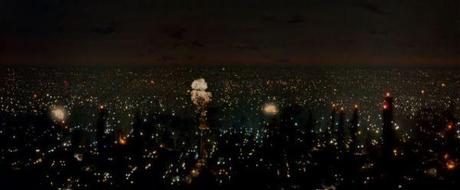
In the director’s commentary and making-of features that accompany the deluxe Final Cut edition of Blade Runner, the consensus of all those talking heads was that the all-seeing, all-knowing eye is everywhere at once, one of many deliberate nods to George Orwell’s 1984 that present themselves throughout the picture.
From the opening panorama of a postmodern Los Angeles skyline, with its gargantuan flames and shafts of blast-furnaces that billow up from below ground — a frightening apparition of an Earthbound inferno — to the aerial view of flying cars, or “spinners,” encircled by beams of light that stream by the endless landscape, we’re in the presence of a vastness of scale unimaginable to the mortal mind.
In the scene immediately following, those red and yellow flames are reflected, left to right, inside the backdrop of an enormous eye, a stupendous close-up shot that encompasses the entire length of the widescreen field. They speak of dreams kept carefully under wraps, burning desires still raging within the eye of the beholder.
Is this beholder Big Brother himself, watching cautiously from a vantage point atop what looks to be a pyramid-like structure? No, he’s only human, just a fellow named Holden (Morgan Paull). He’s a functionary of the massive Tyrell Corporation which the structure represents. From the safety of his office window, Holden peers out into the distance at the spectacle of fireballs and spinners.
Holden is smoking a cigarette, his contribution to the city’s already polluted atmosphere. Ceiling fans circulate the smoky air above him. He’s preparing to administer the Voigt-Kampff test, a type of empathy assessment given to all new Tyrell Corporation employees, one of whom enters the room. The employee’s name is Leon (Brion James).
Sitting down at the table opposite his examiner, we see a glimpse of Leon’s enlarged eye, distended by the Voigt-Kampff machine to almost half the size of Holden’s initial gaze. The machine measures the reaction of its test-subjects through a series of questions designed to provoke an emotional response. Depending on the degree of emotion recorded, one can determine if the individual is a synthetic android (i.e., Replicant) or a human being.
What it also demonstrates is how humanity remains separated into first- and second-class citizens, despite the progress that human rights has made. The elite of humanity have already departed the planet. Those who remain behind are from the lowest echelons of society and, perforce, are treated as such.
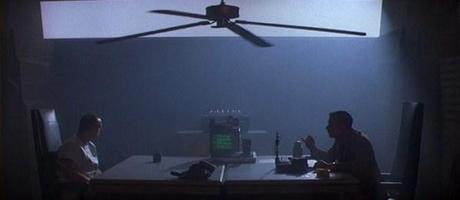
As the test progresses, Leon becomes more and more agitated. His evasive comebacks to such trite queries as “You know what a turtle is?” and “You like it there?” — referring to his place of residence — provide Holden with an opening volley: “Describe in single words the good things that come into your mind about your mother.”
“My mother?” Leon inquires, his eyes narrowing in focus. “Let me tell you about my mother…” He then fires a shot pointblank at Holden from underneath the table, and finishes him off just as Holden goes crashing through the wall.
Leon is one of four escaped Replicants — the others are Roy Batty (Rutger Hauer), Zhora (Joanna Cassidy), and Pris (Daryl Hannah), a “basic pleasure model” — who have fled their Off-world confinement in a slave-labor camp to make the dangerous journey back to Earth. Originally there were six Replicants, but two lost their lives during the escape. The four remaining Replicants are on the run, as the opening titles suggest, and have been dutifully marked for “retirement.” We learn, too, that because of the four-year lifespan their only hope is a return to their point of origin, to find the Maker and convince him to extend their lives.
Befitting the dark themes associated with “urban film noir,” the principal action takes place primarily at night and during a perpetual rainstorm: for all we know, this could be fallout from acid rain or the early stages of a nuclear winter (e.g., the scene of Zhora’s shooting). But no matter what the weather conditions are, they occur within a blighted megalopolis where, despite all those blast furnaces, the sun never shines.
Implicit as well, in the screenplay by Hampton Fancher and David Peoples, is a hint of Schopenhauer’s philosophy whereby nighttime becomes the realm of intrinsic reality.
In the Land of the Blind
Leon links up with Roy Batty, his fellow Nexus 6 runaway, and together they begin their search for the Maker. They pay a visit to Hannibal Chew (James Hong), the Chinese craftsman who plies his eye-making trade in a frosty deep freezer.
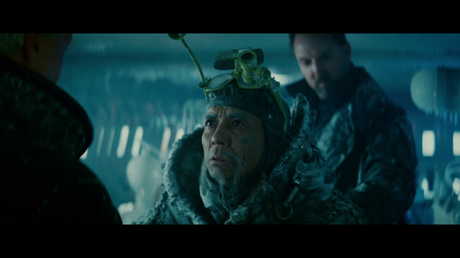
Toying with the old man, Leon places cryogenically frozen eye samples on Chew’s shoulder — the point being that Chew may have missed detection before now, but he won’t escape their notice this time, another analogy to the Big Brother theme, as are the enormous moving faces on the ever-present billboards of oriental women popping treats into their mouths.
The trio’s dialog is clipped and dry. Chew is unable to assist them in prolonging their lives: “I don’t know such stuff, I just do eyes,” he insists briefly, with teeth chattering as he speaks. Chew then asks Roy a question: “You Nexus, huh? I design your eyes.”
“Chew, if only you could see what I’ve seen with your eyes!” Batty confides. From their conversation Roy learns of the existence of J.F. Sebastian (William Sanderson), a soft-spoken genetic engineer who could lead them to the elusive Dr. Eldon Tyrell (Joe Turkel), the head of the corporation that bears his name — the Maker and all-mighty father figure.
Tyrell is holed up in his office, which happens to be the master bedroom in which he lives, works and sleeps. The décor is ancient Egyptian. In one corner sits an artificial owl who blinks with luminous eyes; they impart the outward show of wisdom, as in the saying, “As wise as an owl.” Wisdom, however, has eluded the Maker, for Tyrell wears impossibly thick glasses and lenses. Was their purpose to make his eyes more prominent, or merely to boost his image by giving the appearance of greatness?
Paradoxically, the Maker is myopic, which betrays his lack of understanding for the biomechanical beings he’s created. He’s blind to the truth: that one day the Replicants will insist on living beyond their four-year span. This is why the pyramid-shaped edifice that houses the Tyrell Corporation, reminiscent of the Masonic temple of the all-seeing eye, is lopped off at the top: it’s only partially formed and, therefore, lacking in completeness — much as the Replicants themselves are incomplete. They have superior bodies and minds, but lack longevity.
Of what use are brains, looks and brawn if they’re gone in the blink of an eye? “The light that burns twice as bright,” Tyrell declares to Batty, “burns half as long.” Still, the Maker’s own lack of completeness is reflected in his creations, be they office buildings or artificial beings.
Early on in the film, Tyrell invites Rick Deckard (Harrison Ford), a hunter of Replicants, to the front office to perform the Voigt-Kampff test on his latest creation: the beautiful Rachael (Sean Young), a possible Nexus 8 series but introduced as Tyrell’s niece. Once again, we look deeply into a test subject’s eyes (to wit, her soul) by way of a question-and-answer session — this one taking over a hundred questions to get to the desired outcome.
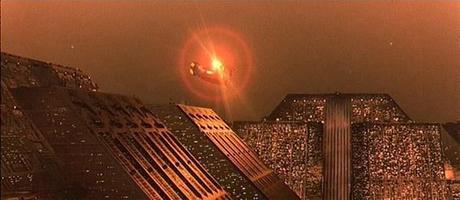
Since Tyrell lives and works in his office, his bedroom can be, for example, both symbolic of sleep and, in many instances, romance and love. It can also represent a place of procreation — specifically, the act of procreating. It was here, in his bedroom office, that Tyrell created the Replicants. And it’s also here that the strongest and most intelligent of the lot — Roy Batty — returns, much like the Prodigal Son, to his place of birth, in a showdown with the Maker: Roy, the embodiment of the fallen angel Lucifer, in direct opposition to Tyrell, or God the father.
But Roy needs direct access to the Maker, an extremely difficult man to “get” to (there’s a double meaning implied in his choice of words), especially after Leon is shot through the head by Rachael, who upon being told that she herself is a Replicant has fled the Tyrell Corporation and followed Deckard to a crowded street (lucky for him).
Prior to Leon’s demise, the Replicant attempts to dispose of Deckard by putting two fingers into his eye sockets, thus telegraphing to the viewer Batty’s immediate intentions and the eventual fate of Dr. Tyrell. Leon also spouts the same last words — “Time to die” — that Roy will use in his death scene at the end.
In the meantime, Pris is sent on ahead to gain J.F. Sebastian’s confidence. She meets him in front of his apartment complex, the stately Bradbury Building in L.A. Once she’s accepted as his friend, Pris and Sebastian are soon joined by Roy.
Sebastian is only 25, but he looks much older than his years. He tells the Replicants that he suffers from the Methuselah Syndrome, a degenerative disease that involves rapid aging. The irony here, then, is that a human has undergone biological transformation via an altered or deformed, or even a malfunctioning gene, which renders him old before his time; while the artificial beings, the Replicants, have been purposely bred to have shortened lives, but with no apparent aging.
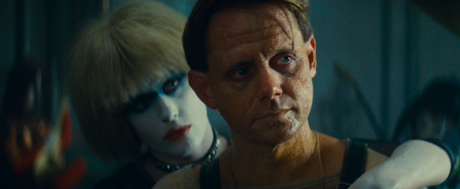
Replicants are former test tube babies who have outgrown the test tube and are seeking knowledge of the world on their own. But the only knowledge they’ve gained in their shortened existence is that life is hard labor and drudgery, and that it will end for them at age four (“Built-in fail-safe device… ”). The following dialog encapsulates all the sadness, anguish and poignancy shared by both humans and Replicants:
Sebastian: “My glands. They grow old too fast.”
Pris: “Is that why you’re still on earth?”
Sebastian: “Yeah, I couldn’t pass the medical.”
And then, a little while later, when Roy Batty enters the picture:
Roy: “We’ve got a lot in common.”
Sebastian: “What do you mean?”
Roy: “Similar problems.”
Pris: “Accelerated decrepitude.”
Sebastian: “I don’t know much about biomechanics, Roy, I wish I did.”
Roy: “If we don’t find help soon, Pris hasn’t got long to live. We can’t allow that.”
(From the Blade Runner movie script – Final script: February 23, 1981)
Through a chance encounter with a game of chess in which Roy discovers that Tyrell is Sebastian’s opponent, he convinces the young man, who’s become sympathetic to their cause, to pique Tyrell’s interest in an unusual chess move. This is enough to allow the two of them entry into Tyrell’s inner sanctum. Tyrell expresses surprise that his creation didn’t come there sooner.
Significantly, Batty kisses the Maker before he kills him. Those familiar with Shakespeare’s Othello may recall the Moor’s final speech that closes the tragedy: “I kissed thee ere I killed thee, no way but this. Killing myself, to die upon a kiss.” Of course, Batty has no plans to “kill” himself. That would go against his nature, as well as the raison d’être for his visit to Tyrell: to prolong his existence.
“I want more life,” he snaps at the Maker, visibly irritated.
“You were made as well as we could make you,” answers Tyrell. “You’re quite a prize. Revel in your time.”
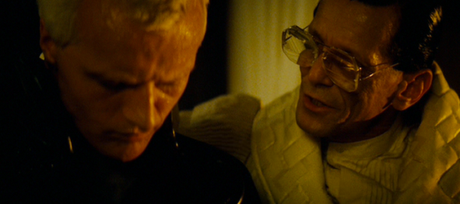
Tyrell’s fate at the hands of his greatest creation is the most significant episode in the drama: it’s the highpoint of their confrontation, as well as a sweeping arc that takes us directly to the Maker’s execution, the death of their God, by the plucking of his eyes from their sockets; followed swiftly by the crushing of Tyrell’s head. He will no longer see, he will no longer think; he’ll be blinded, as Oedipus had blinded himself, for his sins (Samson, too, was blinded after he lost his strength, a physical representation of his having lost his way).
Tyrell’s soul has been eviscerated. There will be no more Replicants, no more slave labor by second-class citizens once the last of the Replicants have died out. The Maker’s pet owl, synonymous with Wotan’s ravens, watches silently close by. Powerless to intervene, the owl can only blink its huge eyes at the murder of its master. This definitive end to the Maker, however, and his capitalistic schemes neither fulfills nor satisfies the desperate Roy Batty. Instead, it horrifies the innocent onlooker Sebastian, who makes a move to flee the terrible scene. Roy corners and murders him, leaving the corpse behind as evidence of his foul deed.
The Man with One Eye is King
Sebastian was the only person allowed to accompany Roy on his way up to Tyrell’s office apartment. But Roy is now the lone occupant of the elevator that takes him down to street level and away from the scene of the crime: first, his ascent into Heaven; and then, his descent from the heavens back down to Earth, and to an earthly Hell. The image of Dante’s Inferno runs rampant throughout Blade Runner, and returns again for one last go-around.

With its promise of a hopeful future, Off-world becomes the new Paradise, which we hear about constantly in the background and foreground of shots that defy the imagination. Immense flying advertisements, bloated dirigibles, billboards with screens, broadcast the wonders of a new life in distant Off-world colonies. Let the biomechanical Replicants slave away for the limited time they’re on the Earth; the “real” humans, i.e., those few with means and the wherewithal to leave, will live out their existence in Paradise (or Paradise Lost, whichever comes first).
Turning to Roy Batty’s final speech, I don’t know of a more fitting end to all that has gone on before than his poetic farewell to life. The entire film’s themes are summed up in this brief apotheosis to an undeserving mankind. It begins as soon as Deckard takes his first potshot at Roy’s body. Having wounded him, Roy reacts by letting out a wolf’s howl. Baying at the ceiling, in one last song before dying, he grabs hold of a nail and thrusts it into his right hand. Roy runs off down the hallway, occasionally poking his head through the wall to spout little pearls of wisdom: “Four, five, how to stay alive… Six, seven, go to Hell, go to Heaven.” When you have only minutes left to live, you make the most of what little time remains.
In a way, Roy sacrifices what life he has left to save Deckard, the bounty hunter, or “Blade Runner” of the title, who’s been on the lookout for him since the story began. A life for a life: “Kinship,” Batty shouts at the end, grabbing hold of Deckard’s left arm with his own impaled right hand. He prevents Deckard from taking the “fall” for Roy’s crimes. Roy Batty’s piercing blue eyes glower at Deckard: they are lit up with the flickering flame of life ticking by. Only seconds left to his redemption.
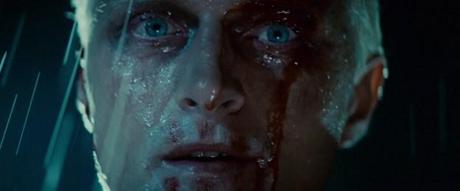
Roy acquires his humanity by empathizing with mankind. He first learns from Sebastian’s example, who unfortunately dies for witnessing the murder of the Maker. Indeed, the entire film is an homage to humanity, represented by its eyes, the orbs by which humans (and their human imitators, the Replicants) reveal themselves to the world, learn from the world and, in the final analysis, grow to attain the knowledge required to survive in the world; while passing on that knowledge to those deemed worthy enough to profit from it. This is what humans do, and this is the omnipresent theme of Blade Runner, the exploration of one’s humanity and its eventual attainment:
“I’ve seen things you people wouldn’t believe…” Roy announces to Deckard. “Attack ships on fire off the shoulders of Orion. I watched c-beams glitter in the dark near the Tannhäuser Gate. All those moments… will be lost in time, like… tears in rain… Time to die…”
Roy has “seen things,” which indicates he has personally witnessed, and experienced, these marvels. “I watched c-beams glitter in the dark” is a phrase that encompasses an image of the night sky, lit up and enveloping the massive horizon, a metaphor for death as it makes its stealthy approach.
Finally, the last phrase “all those moments will be lost in time,” indicative of time running out: the “tears” obliterate sight; one cannot see when one’s eyes are filled with tears. That is the physiological manifestation of blurred vision — “seeing” equates to “knowing,” or gaining the knowledge of things… of the world… of miracles (such as those Roy describes above). Tears mix with rain. The rain continues to pour down Roy Batty’s face, washing the tears away. Again, the analogy is to Roy’s accumulated knowledge, being lost forever.
His sins have been washed away, a purging of his tortured soul. These words from Ezekiel 18:20, in the American Standard Version of the Bible, read as follows: “The soul that sinneth, it shall die: the son shall not bear the iniquity of the father, neither shall the father bear the iniquity of the son.” Both Roy’s and Tyrell’s misdeeds have been forgiven.
Our final glimpse of Roy is the closing of his eyes and the ritualized lowering of his head, both an unconscious and, quite possibly, deliberate bow to Deckard, a nod of understanding that knowledge has been passed on from Roy to Deckard, a human being (or so we believe), who can learn, perhaps profit from his proximity to this most extraordinary of beings: Roy Batty, at last a “human” through empathy. And Deckard, the pure fool made wise through pity and compassion for the non-human Roy.
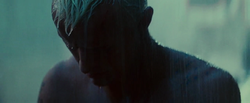
No more tears, no more seeing, no more watching. He sleeps now. The spontaneous release of the dove Roy carries with him flies away to the sky; it’s the launching of Roy Batty’s soul — or whatever it is that Replicants have that equates to a human soul, leaving the physical boundaries of terra firma and flying heavenward to freedom. Perhaps back to the Tannhäuser Gate.
But the story does not end with Roy’ death. There’s one more Replicant to go: the beautiful Rachael. She waits in Deckard’s apartment, but is she alive? Is she dead? Did the lame blade runner, Gaff (Edward James Olmos), who revels in making matchstick figures and animal origami, dispose of her body before Deckard arrived, before he had a chance to save her life?
In Ridley Scott’s Final Cut of the film, there is no “happy ending” for the lovers, only the expectation that by running away the former Blade Runner can have a life outside his distasteful profession, i.e., that of a killer of runaway androids. Having been redeemed by Roy’s death, Deckard embarks on his own journey: to freedom, to liberation? To one of the Off-world colonies? We can only surmise.
But before he and Rachael can get away, Deckard spots something on the floor. It’s a tinfoil figure of a unicorn, the same mythological creature that appeared in his dream. The voiceover reiterates Gaff’s spoken lines, heard on the rooftop of the Bradbury Building where Batty ceased to exist: “It’s too bad she won’t live. But then again, who does?”
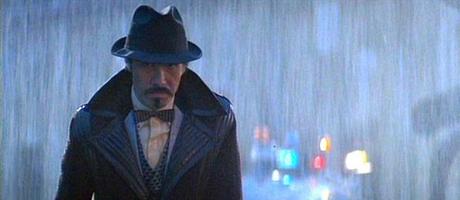
Deckard nods in agreement, crushes the unicorn in his fist, and takes off with Rachael for parts unknown.
The window into men’s souls has been opened. Deckard peered into it, and was changed by what he saw. Like Roy with Sebastian, he and Batty are so alike, yet so different. They’ve seen things, they’ve done things: “Questionable things,” according to Batty, before he blinded and killed his Maker. Who is more deserving of a future, the human or the Replicant? What did Deckard learn from Roy about life and living? Does this mean Rachael has a limited life span? And is Deckard himself a Replicant?
We aren’t told any of the answers, nor are we assured the couple will have a blissful, carefree life together — or for how long. There is no formal end to the story, and those familiar yet comforting words that bring this and other familiar tales to their logical conclusion are never spoken: “And they lived happily ever after.” Did they? Really?
We don’t know the answer. But then again, who does? Ω
Blade Runner (1982)
Produced by Michael Deeley; directed by Ridley Scott; screenplay by Hampton Fancher and David Peoples; based on the book Do Androids Dream of Electric Sheep? by Philip K. Dick; cinematography by Jordan Cronenweth; edited by Terry Rawlings; production design by Laurence G. Paull; art direction by David Snyder; concept art by Syd Mead; special effects supervised by Douglas Trumbull and Richard Yuricich; costume design by Charles Knode and Michael Kaplan; music by Vangelis; starring Harrison Ford, Rutger Hauer, Sean Young, Joanna Cassidy, Daryl Hannah, William Sanderson, Edward James Olmos, Joe Turkell, M. Emmett Walsh, James Hong and Morgan Paull. Color, 116 min. (Final Cut), the Ladd Company, distributed by Warner Brothers.
Copyright © 2014 by Josmar F. Lopes

